Anatomy, Physiology, Disease, and Health: A Comprehensive Overview
VerifiedAdded on 2020/10/22
|10
|2800
|61
Report
AI Summary
This report provides an overview of human anatomy and physiology, emphasizing the interconnectedness of body systems and their functions. It discusses the nervous, respiratory, and musculoskeletal systems, highlighting their roles in maintaining health and the consequences of dysfunction. The report also defines health and disease, differentiating between communicable and non-communicable diseases. It further explores the impact of diseases such as Alzheimer's, stroke, tuberculosis, asthma, arthritis, and osteomalacia on physical and mental well-being. The conclusion emphasizes the importance of physiological principles in healthcare and the need for careful planning in diagnosing and treating health issues.
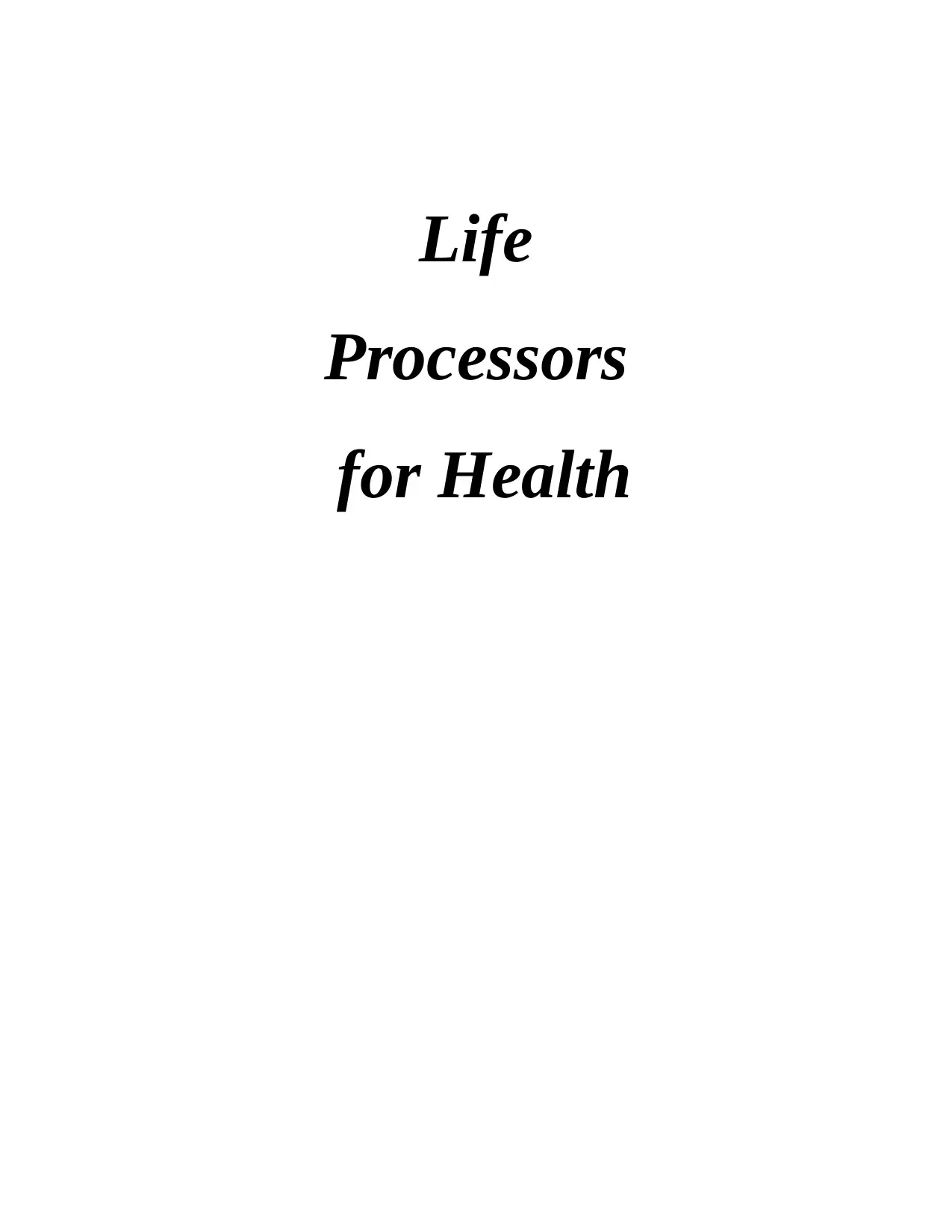
Life
Processors
for Health
Processors
for Health
Paraphrase This Document
Need a fresh take? Get an instant paraphrase of this document with our AI Paraphraser
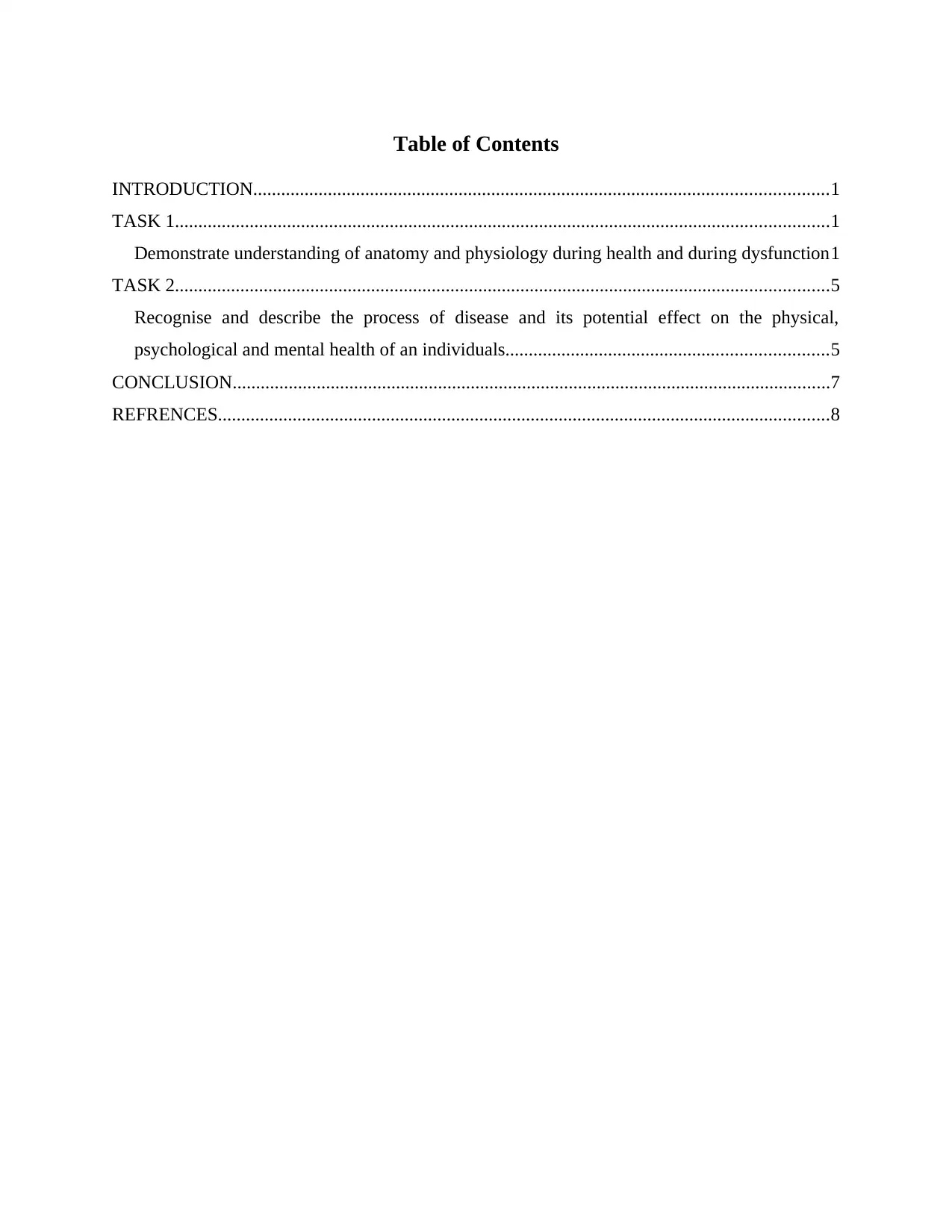
Table of Contents
INTRODUCTION...........................................................................................................................1
TASK 1............................................................................................................................................1
Demonstrate understanding of anatomy and physiology during health and during dysfunction1
TASK 2............................................................................................................................................5
Recognise and describe the process of disease and its potential effect on the physical,
psychological and mental health of an individuals.....................................................................5
CONCLUSION................................................................................................................................7
REFRENCES...................................................................................................................................8
INTRODUCTION...........................................................................................................................1
TASK 1............................................................................................................................................1
Demonstrate understanding of anatomy and physiology during health and during dysfunction1
TASK 2............................................................................................................................................5
Recognise and describe the process of disease and its potential effect on the physical,
psychological and mental health of an individuals.....................................................................5
CONCLUSION................................................................................................................................7
REFRENCES...................................................................................................................................8
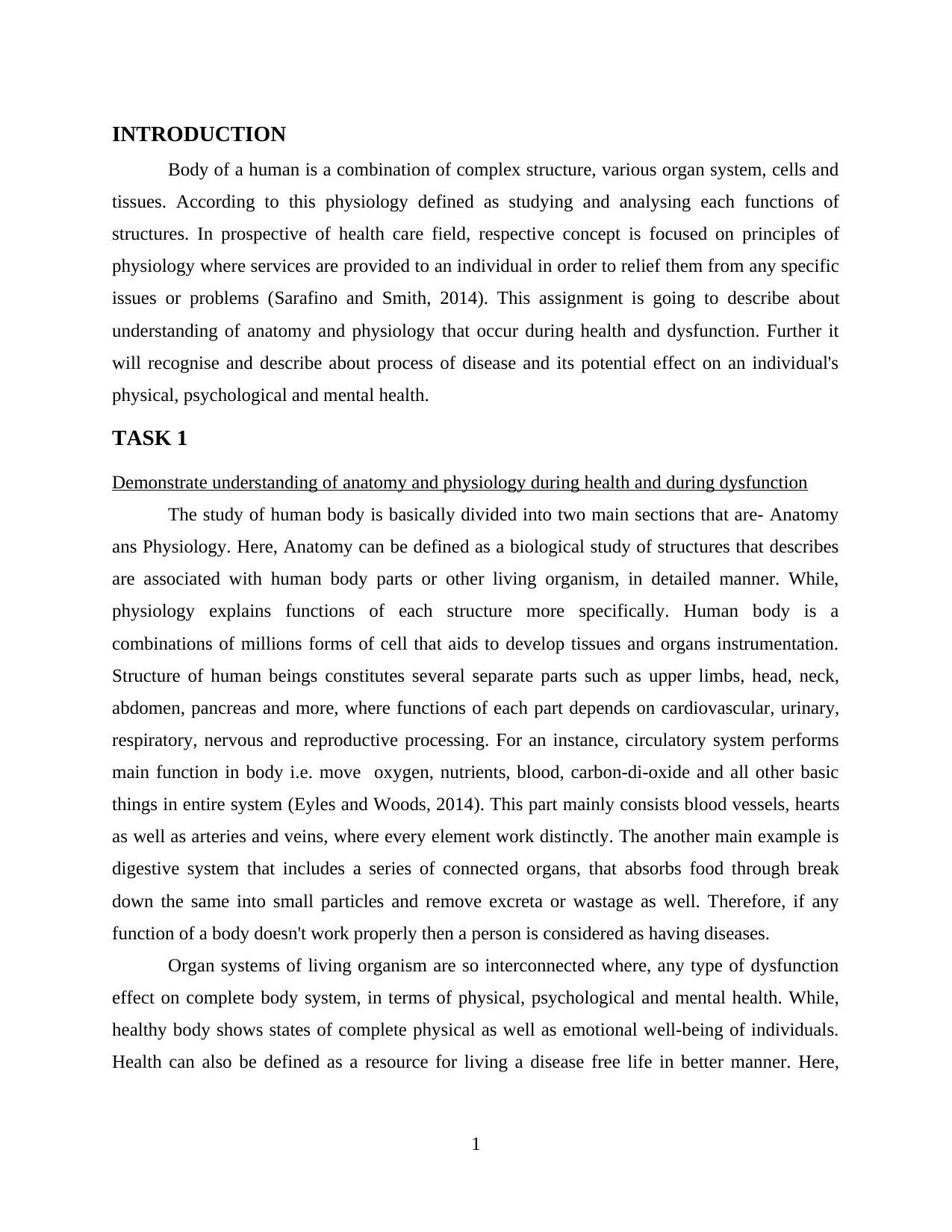
INTRODUCTION
Body of a human is a combination of complex structure, various organ system, cells and
tissues. According to this physiology defined as studying and analysing each functions of
structures. In prospective of health care field, respective concept is focused on principles of
physiology where services are provided to an individual in order to relief them from any specific
issues or problems (Sarafino and Smith, 2014). This assignment is going to describe about
understanding of anatomy and physiology that occur during health and dysfunction. Further it
will recognise and describe about process of disease and its potential effect on an individual's
physical, psychological and mental health.
TASK 1
Demonstrate understanding of anatomy and physiology during health and during dysfunction
The study of human body is basically divided into two main sections that are- Anatomy
ans Physiology. Here, Anatomy can be defined as a biological study of structures that describes
are associated with human body parts or other living organism, in detailed manner. While,
physiology explains functions of each structure more specifically. Human body is a
combinations of millions forms of cell that aids to develop tissues and organs instrumentation.
Structure of human beings constitutes several separate parts such as upper limbs, head, neck,
abdomen, pancreas and more, where functions of each part depends on cardiovascular, urinary,
respiratory, nervous and reproductive processing. For an instance, circulatory system performs
main function in body i.e. move oxygen, nutrients, blood, carbon-di-oxide and all other basic
things in entire system (Eyles and Woods, 2014). This part mainly consists blood vessels, hearts
as well as arteries and veins, where every element work distinctly. The another main example is
digestive system that includes a series of connected organs, that absorbs food through break
down the same into small particles and remove excreta or wastage as well. Therefore, if any
function of a body doesn't work properly then a person is considered as having diseases.
Organ systems of living organism are so interconnected where, any type of dysfunction
effect on complete body system, in terms of physical, psychological and mental health. While,
healthy body shows states of complete physical as well as emotional well-being of individuals.
Health can also be defined as a resource for living a disease free life in better manner. Here,
1
Body of a human is a combination of complex structure, various organ system, cells and
tissues. According to this physiology defined as studying and analysing each functions of
structures. In prospective of health care field, respective concept is focused on principles of
physiology where services are provided to an individual in order to relief them from any specific
issues or problems (Sarafino and Smith, 2014). This assignment is going to describe about
understanding of anatomy and physiology that occur during health and dysfunction. Further it
will recognise and describe about process of disease and its potential effect on an individual's
physical, psychological and mental health.
TASK 1
Demonstrate understanding of anatomy and physiology during health and during dysfunction
The study of human body is basically divided into two main sections that are- Anatomy
ans Physiology. Here, Anatomy can be defined as a biological study of structures that describes
are associated with human body parts or other living organism, in detailed manner. While,
physiology explains functions of each structure more specifically. Human body is a
combinations of millions forms of cell that aids to develop tissues and organs instrumentation.
Structure of human beings constitutes several separate parts such as upper limbs, head, neck,
abdomen, pancreas and more, where functions of each part depends on cardiovascular, urinary,
respiratory, nervous and reproductive processing. For an instance, circulatory system performs
main function in body i.e. move oxygen, nutrients, blood, carbon-di-oxide and all other basic
things in entire system (Eyles and Woods, 2014). This part mainly consists blood vessels, hearts
as well as arteries and veins, where every element work distinctly. The another main example is
digestive system that includes a series of connected organs, that absorbs food through break
down the same into small particles and remove excreta or wastage as well. Therefore, if any
function of a body doesn't work properly then a person is considered as having diseases.
Organ systems of living organism are so interconnected where, any type of dysfunction
effect on complete body system, in terms of physical, psychological and mental health. While,
healthy body shows states of complete physical as well as emotional well-being of individuals.
Health can also be defined as a resource for living a disease free life in better manner. Here,
1
⊘ This is a preview!⊘
Do you want full access?
Subscribe today to unlock all pages.

Trusted by 1+ million students worldwide
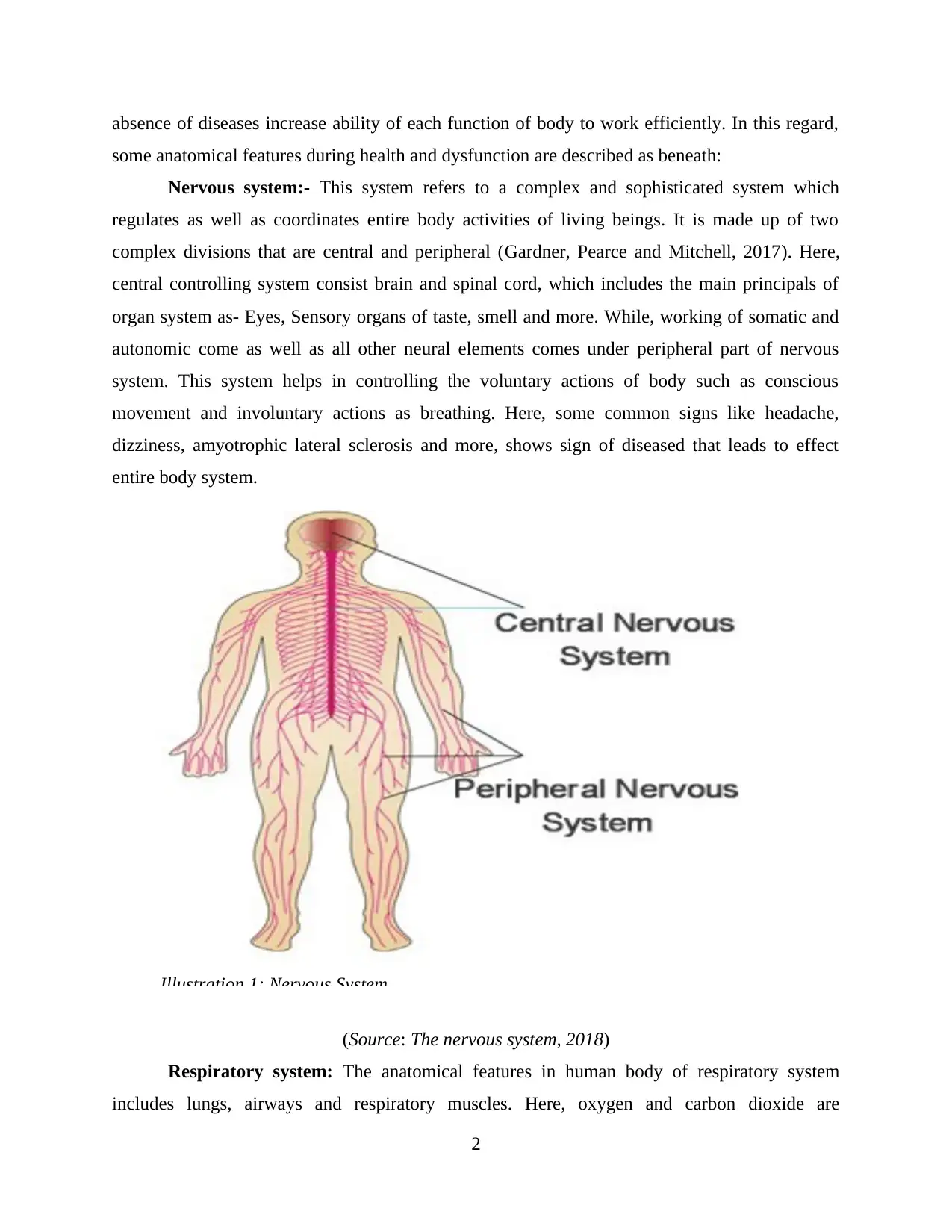
absence of diseases increase ability of each function of body to work efficiently. In this regard,
some anatomical features during health and dysfunction are described as beneath:
Nervous system:- This system refers to a complex and sophisticated system which
regulates as well as coordinates entire body activities of living beings. It is made up of two
complex divisions that are central and peripheral (Gardner, Pearce and Mitchell, 2017). Here,
central controlling system consist brain and spinal cord, which includes the main principals of
organ system as- Eyes, Sensory organs of taste, smell and more. While, working of somatic and
autonomic come as well as all other neural elements comes under peripheral part of nervous
system. This system helps in controlling the voluntary actions of body such as conscious
movement and involuntary actions as breathing. Here, some common signs like headache,
dizziness, amyotrophic lateral sclerosis and more, shows sign of diseased that leads to effect
entire body system.
(Source: The nervous system, 2018)
Respiratory system: The anatomical features in human body of respiratory system
includes lungs, airways and respiratory muscles. Here, oxygen and carbon dioxide are
2
Illustration 1: Nervous System
some anatomical features during health and dysfunction are described as beneath:
Nervous system:- This system refers to a complex and sophisticated system which
regulates as well as coordinates entire body activities of living beings. It is made up of two
complex divisions that are central and peripheral (Gardner, Pearce and Mitchell, 2017). Here,
central controlling system consist brain and spinal cord, which includes the main principals of
organ system as- Eyes, Sensory organs of taste, smell and more. While, working of somatic and
autonomic come as well as all other neural elements comes under peripheral part of nervous
system. This system helps in controlling the voluntary actions of body such as conscious
movement and involuntary actions as breathing. Here, some common signs like headache,
dizziness, amyotrophic lateral sclerosis and more, shows sign of diseased that leads to effect
entire body system.
(Source: The nervous system, 2018)
Respiratory system: The anatomical features in human body of respiratory system
includes lungs, airways and respiratory muscles. Here, oxygen and carbon dioxide are
2
Illustration 1: Nervous System
Paraphrase This Document
Need a fresh take? Get an instant paraphrase of this document with our AI Paraphraser
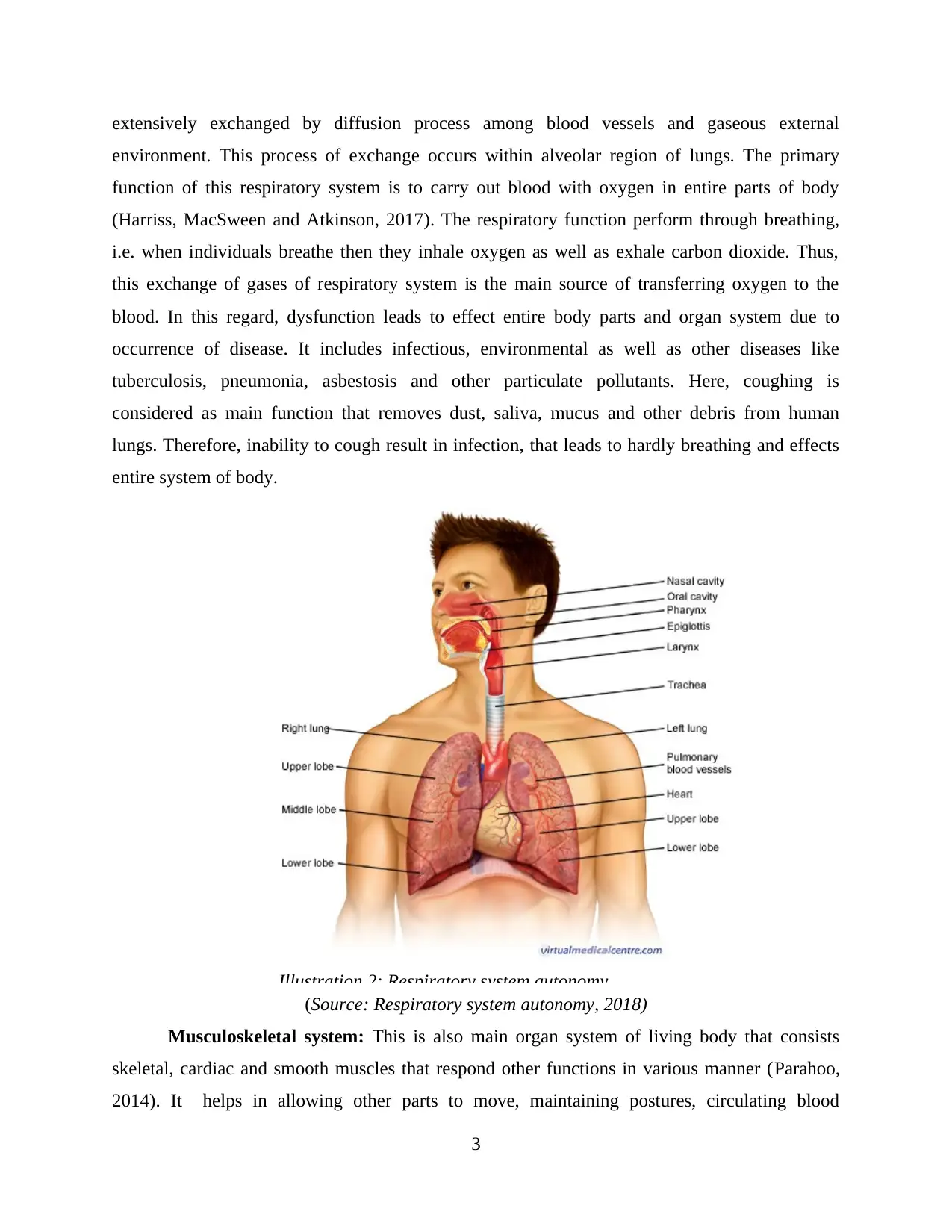
extensively exchanged by diffusion process among blood vessels and gaseous external
environment. This process of exchange occurs within alveolar region of lungs. The primary
function of this respiratory system is to carry out blood with oxygen in entire parts of body
(Harriss, MacSween and Atkinson, 2017). The respiratory function perform through breathing,
i.e. when individuals breathe then they inhale oxygen as well as exhale carbon dioxide. Thus,
this exchange of gases of respiratory system is the main source of transferring oxygen to the
blood. In this regard, dysfunction leads to effect entire body parts and organ system due to
occurrence of disease. It includes infectious, environmental as well as other diseases like
tuberculosis, pneumonia, asbestosis and other particulate pollutants. Here, coughing is
considered as main function that removes dust, saliva, mucus and other debris from human
lungs. Therefore, inability to cough result in infection, that leads to hardly breathing and effects
entire system of body.
(Source: Respiratory system autonomy, 2018)
Musculoskeletal system: This is also main organ system of living body that consists
skeletal, cardiac and smooth muscles that respond other functions in various manner (Parahoo,
2014). It helps in allowing other parts to move, maintaining postures, circulating blood
3
Illustration 2: Respiratory system autonomy
environment. This process of exchange occurs within alveolar region of lungs. The primary
function of this respiratory system is to carry out blood with oxygen in entire parts of body
(Harriss, MacSween and Atkinson, 2017). The respiratory function perform through breathing,
i.e. when individuals breathe then they inhale oxygen as well as exhale carbon dioxide. Thus,
this exchange of gases of respiratory system is the main source of transferring oxygen to the
blood. In this regard, dysfunction leads to effect entire body parts and organ system due to
occurrence of disease. It includes infectious, environmental as well as other diseases like
tuberculosis, pneumonia, asbestosis and other particulate pollutants. Here, coughing is
considered as main function that removes dust, saliva, mucus and other debris from human
lungs. Therefore, inability to cough result in infection, that leads to hardly breathing and effects
entire system of body.
(Source: Respiratory system autonomy, 2018)
Musculoskeletal system: This is also main organ system of living body that consists
skeletal, cardiac and smooth muscles that respond other functions in various manner (Parahoo,
2014). It helps in allowing other parts to move, maintaining postures, circulating blood
3
Illustration 2: Respiratory system autonomy
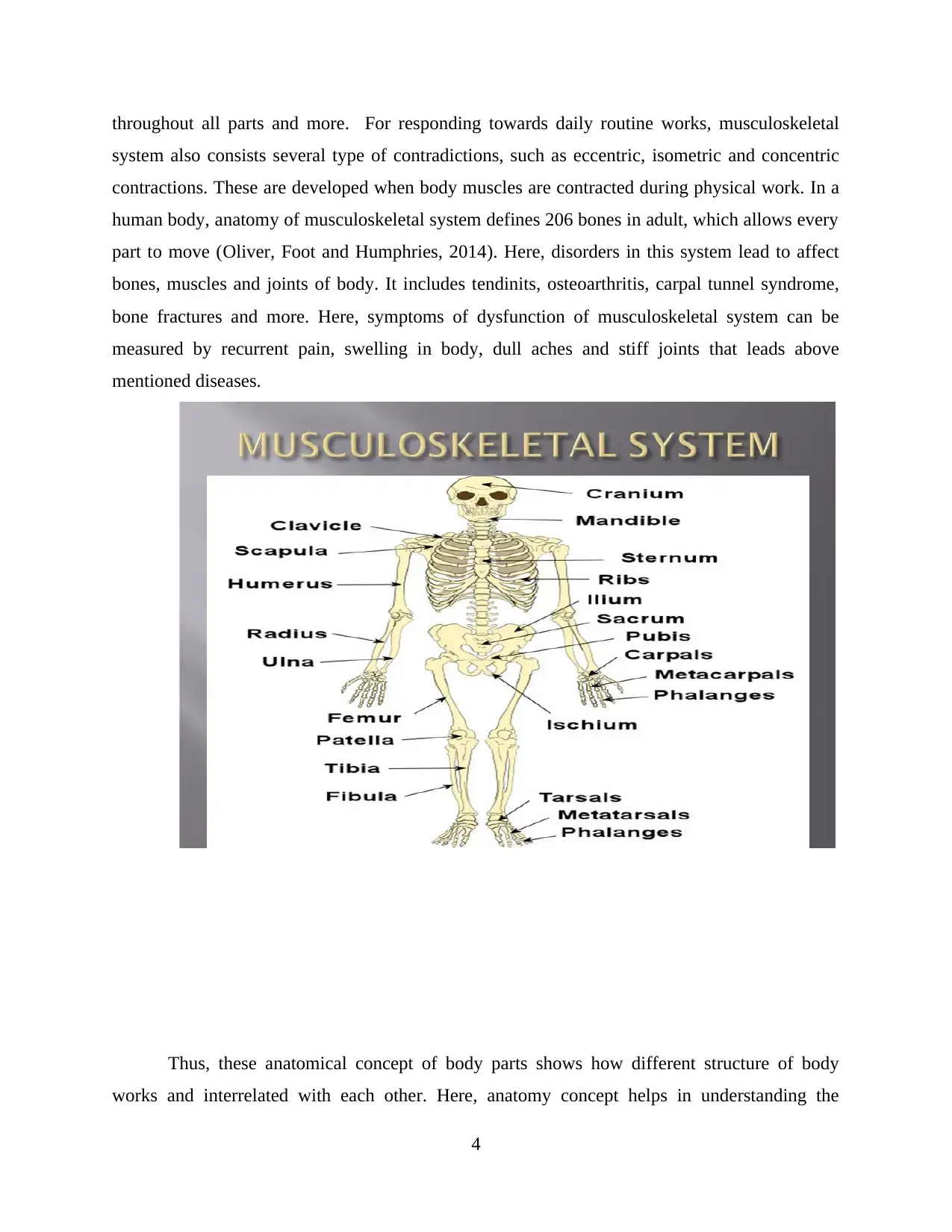
throughout all parts and more. For responding towards daily routine works, musculoskeletal
system also consists several type of contradictions, such as eccentric, isometric and concentric
contractions. These are developed when body muscles are contracted during physical work. In a
human body, anatomy of musculoskeletal system defines 206 bones in adult, which allows every
part to move (Oliver, Foot and Humphries, 2014). Here, disorders in this system lead to affect
bones, muscles and joints of body. It includes tendinits, osteoarthritis, carpal tunnel syndrome,
bone fractures and more. Here, symptoms of dysfunction of musculoskeletal system can be
measured by recurrent pain, swelling in body, dull aches and stiff joints that leads above
mentioned diseases.
Thus, these anatomical concept of body parts shows how different structure of body
works and interrelated with each other. Here, anatomy concept helps in understanding the
4
system also consists several type of contradictions, such as eccentric, isometric and concentric
contractions. These are developed when body muscles are contracted during physical work. In a
human body, anatomy of musculoskeletal system defines 206 bones in adult, which allows every
part to move (Oliver, Foot and Humphries, 2014). Here, disorders in this system lead to affect
bones, muscles and joints of body. It includes tendinits, osteoarthritis, carpal tunnel syndrome,
bone fractures and more. Here, symptoms of dysfunction of musculoskeletal system can be
measured by recurrent pain, swelling in body, dull aches and stiff joints that leads above
mentioned diseases.
Thus, these anatomical concept of body parts shows how different structure of body
works and interrelated with each other. Here, anatomy concept helps in understanding the
4
⊘ This is a preview!⊘
Do you want full access?
Subscribe today to unlock all pages.

Trusted by 1+ million students worldwide
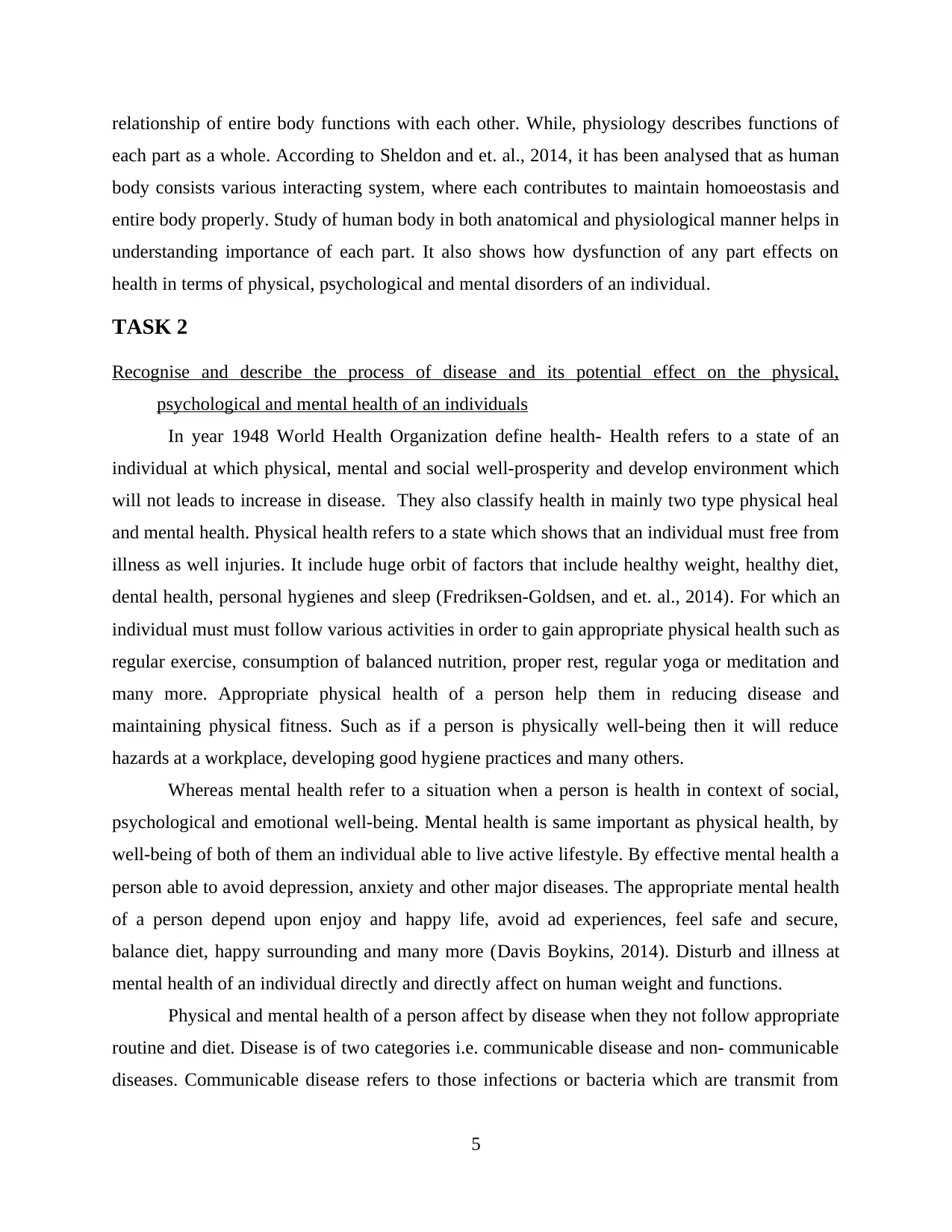
relationship of entire body functions with each other. While, physiology describes functions of
each part as a whole. According to Sheldon and et. al., 2014, it has been analysed that as human
body consists various interacting system, where each contributes to maintain homoeostasis and
entire body properly. Study of human body in both anatomical and physiological manner helps in
understanding importance of each part. It also shows how dysfunction of any part effects on
health in terms of physical, psychological and mental disorders of an individual.
TASK 2
Recognise and describe the process of disease and its potential effect on the physical,
psychological and mental health of an individuals
In year 1948 World Health Organization define health- Health refers to a state of an
individual at which physical, mental and social well-prosperity and develop environment which
will not leads to increase in disease. They also classify health in mainly two type physical heal
and mental health. Physical health refers to a state which shows that an individual must free from
illness as well injuries. It include huge orbit of factors that include healthy weight, healthy diet,
dental health, personal hygienes and sleep (Fredriksen-Goldsen, and et. al., 2014). For which an
individual must must follow various activities in order to gain appropriate physical health such as
regular exercise, consumption of balanced nutrition, proper rest, regular yoga or meditation and
many more. Appropriate physical health of a person help them in reducing disease and
maintaining physical fitness. Such as if a person is physically well-being then it will reduce
hazards at a workplace, developing good hygiene practices and many others.
Whereas mental health refer to a situation when a person is health in context of social,
psychological and emotional well-being. Mental health is same important as physical health, by
well-being of both of them an individual able to live active lifestyle. By effective mental health a
person able to avoid depression, anxiety and other major diseases. The appropriate mental health
of a person depend upon enjoy and happy life, avoid ad experiences, feel safe and secure,
balance diet, happy surrounding and many more (Davis Boykins, 2014). Disturb and illness at
mental health of an individual directly and directly affect on human weight and functions.
Physical and mental health of a person affect by disease when they not follow appropriate
routine and diet. Disease is of two categories i.e. communicable disease and non- communicable
diseases. Communicable disease refers to those infections or bacteria which are transmit from
5
each part as a whole. According to Sheldon and et. al., 2014, it has been analysed that as human
body consists various interacting system, where each contributes to maintain homoeostasis and
entire body properly. Study of human body in both anatomical and physiological manner helps in
understanding importance of each part. It also shows how dysfunction of any part effects on
health in terms of physical, psychological and mental disorders of an individual.
TASK 2
Recognise and describe the process of disease and its potential effect on the physical,
psychological and mental health of an individuals
In year 1948 World Health Organization define health- Health refers to a state of an
individual at which physical, mental and social well-prosperity and develop environment which
will not leads to increase in disease. They also classify health in mainly two type physical heal
and mental health. Physical health refers to a state which shows that an individual must free from
illness as well injuries. It include huge orbit of factors that include healthy weight, healthy diet,
dental health, personal hygienes and sleep (Fredriksen-Goldsen, and et. al., 2014). For which an
individual must must follow various activities in order to gain appropriate physical health such as
regular exercise, consumption of balanced nutrition, proper rest, regular yoga or meditation and
many more. Appropriate physical health of a person help them in reducing disease and
maintaining physical fitness. Such as if a person is physically well-being then it will reduce
hazards at a workplace, developing good hygiene practices and many others.
Whereas mental health refer to a situation when a person is health in context of social,
psychological and emotional well-being. Mental health is same important as physical health, by
well-being of both of them an individual able to live active lifestyle. By effective mental health a
person able to avoid depression, anxiety and other major diseases. The appropriate mental health
of a person depend upon enjoy and happy life, avoid ad experiences, feel safe and secure,
balance diet, happy surrounding and many more (Davis Boykins, 2014). Disturb and illness at
mental health of an individual directly and directly affect on human weight and functions.
Physical and mental health of a person affect by disease when they not follow appropriate
routine and diet. Disease is of two categories i.e. communicable disease and non- communicable
diseases. Communicable disease refers to those infections or bacteria which are transmit from
5
Paraphrase This Document
Need a fresh take? Get an instant paraphrase of this document with our AI Paraphraser
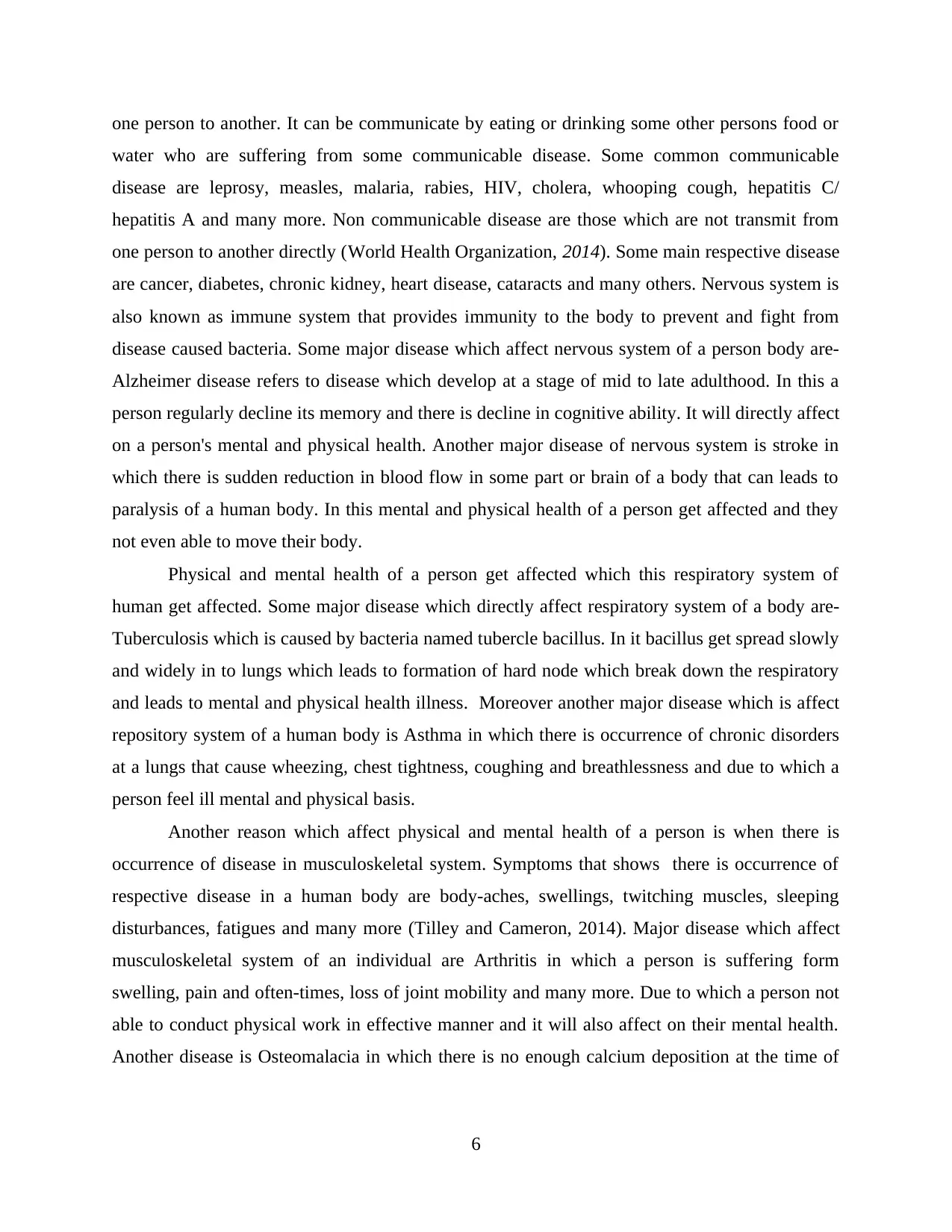
one person to another. It can be communicate by eating or drinking some other persons food or
water who are suffering from some communicable disease. Some common communicable
disease are leprosy, measles, malaria, rabies, HIV, cholera, whooping cough, hepatitis C/
hepatitis A and many more. Non communicable disease are those which are not transmit from
one person to another directly (World Health Organization, 2014). Some main respective disease
are cancer, diabetes, chronic kidney, heart disease, cataracts and many others. Nervous system is
also known as immune system that provides immunity to the body to prevent and fight from
disease caused bacteria. Some major disease which affect nervous system of a person body are-
Alzheimer disease refers to disease which develop at a stage of mid to late adulthood. In this a
person regularly decline its memory and there is decline in cognitive ability. It will directly affect
on a person's mental and physical health. Another major disease of nervous system is stroke in
which there is sudden reduction in blood flow in some part or brain of a body that can leads to
paralysis of a human body. In this mental and physical health of a person get affected and they
not even able to move their body.
Physical and mental health of a person get affected which this respiratory system of
human get affected. Some major disease which directly affect respiratory system of a body are-
Tuberculosis which is caused by bacteria named tubercle bacillus. In it bacillus get spread slowly
and widely in to lungs which leads to formation of hard node which break down the respiratory
and leads to mental and physical health illness. Moreover another major disease which is affect
repository system of a human body is Asthma in which there is occurrence of chronic disorders
at a lungs that cause wheezing, chest tightness, coughing and breathlessness and due to which a
person feel ill mental and physical basis.
Another reason which affect physical and mental health of a person is when there is
occurrence of disease in musculoskeletal system. Symptoms that shows there is occurrence of
respective disease in a human body are body-aches, swellings, twitching muscles, sleeping
disturbances, fatigues and many more (Tilley and Cameron, 2014). Major disease which affect
musculoskeletal system of an individual are Arthritis in which a person is suffering form
swelling, pain and often-times, loss of joint mobility and many more. Due to which a person not
able to conduct physical work in effective manner and it will also affect on their mental health.
Another disease is Osteomalacia in which there is no enough calcium deposition at the time of
6
water who are suffering from some communicable disease. Some common communicable
disease are leprosy, measles, malaria, rabies, HIV, cholera, whooping cough, hepatitis C/
hepatitis A and many more. Non communicable disease are those which are not transmit from
one person to another directly (World Health Organization, 2014). Some main respective disease
are cancer, diabetes, chronic kidney, heart disease, cataracts and many others. Nervous system is
also known as immune system that provides immunity to the body to prevent and fight from
disease caused bacteria. Some major disease which affect nervous system of a person body are-
Alzheimer disease refers to disease which develop at a stage of mid to late adulthood. In this a
person regularly decline its memory and there is decline in cognitive ability. It will directly affect
on a person's mental and physical health. Another major disease of nervous system is stroke in
which there is sudden reduction in blood flow in some part or brain of a body that can leads to
paralysis of a human body. In this mental and physical health of a person get affected and they
not even able to move their body.
Physical and mental health of a person get affected which this respiratory system of
human get affected. Some major disease which directly affect respiratory system of a body are-
Tuberculosis which is caused by bacteria named tubercle bacillus. In it bacillus get spread slowly
and widely in to lungs which leads to formation of hard node which break down the respiratory
and leads to mental and physical health illness. Moreover another major disease which is affect
repository system of a human body is Asthma in which there is occurrence of chronic disorders
at a lungs that cause wheezing, chest tightness, coughing and breathlessness and due to which a
person feel ill mental and physical basis.
Another reason which affect physical and mental health of a person is when there is
occurrence of disease in musculoskeletal system. Symptoms that shows there is occurrence of
respective disease in a human body are body-aches, swellings, twitching muscles, sleeping
disturbances, fatigues and many more (Tilley and Cameron, 2014). Major disease which affect
musculoskeletal system of an individual are Arthritis in which a person is suffering form
swelling, pain and often-times, loss of joint mobility and many more. Due to which a person not
able to conduct physical work in effective manner and it will also affect on their mental health.
Another disease is Osteomalacia in which there is no enough calcium deposition at the time of
6
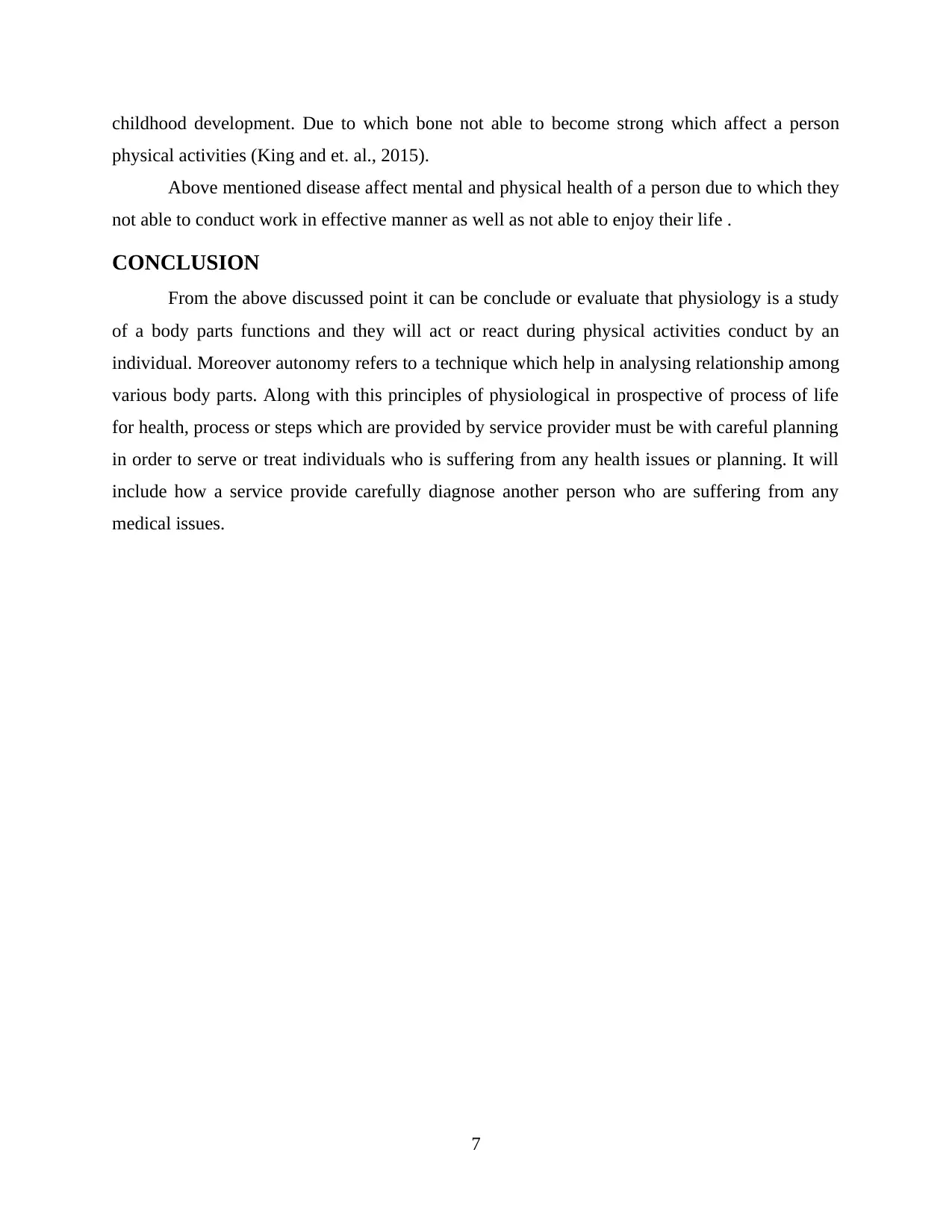
childhood development. Due to which bone not able to become strong which affect a person
physical activities (King and et. al., 2015).
Above mentioned disease affect mental and physical health of a person due to which they
not able to conduct work in effective manner as well as not able to enjoy their life .
CONCLUSION
From the above discussed point it can be conclude or evaluate that physiology is a study
of a body parts functions and they will act or react during physical activities conduct by an
individual. Moreover autonomy refers to a technique which help in analysing relationship among
various body parts. Along with this principles of physiological in prospective of process of life
for health, process or steps which are provided by service provider must be with careful planning
in order to serve or treat individuals who is suffering from any health issues or planning. It will
include how a service provide carefully diagnose another person who are suffering from any
medical issues.
7
physical activities (King and et. al., 2015).
Above mentioned disease affect mental and physical health of a person due to which they
not able to conduct work in effective manner as well as not able to enjoy their life .
CONCLUSION
From the above discussed point it can be conclude or evaluate that physiology is a study
of a body parts functions and they will act or react during physical activities conduct by an
individual. Moreover autonomy refers to a technique which help in analysing relationship among
various body parts. Along with this principles of physiological in prospective of process of life
for health, process or steps which are provided by service provider must be with careful planning
in order to serve or treat individuals who is suffering from any health issues or planning. It will
include how a service provide carefully diagnose another person who are suffering from any
medical issues.
7
⊘ This is a preview!⊘
Do you want full access?
Subscribe today to unlock all pages.

Trusted by 1+ million students worldwide
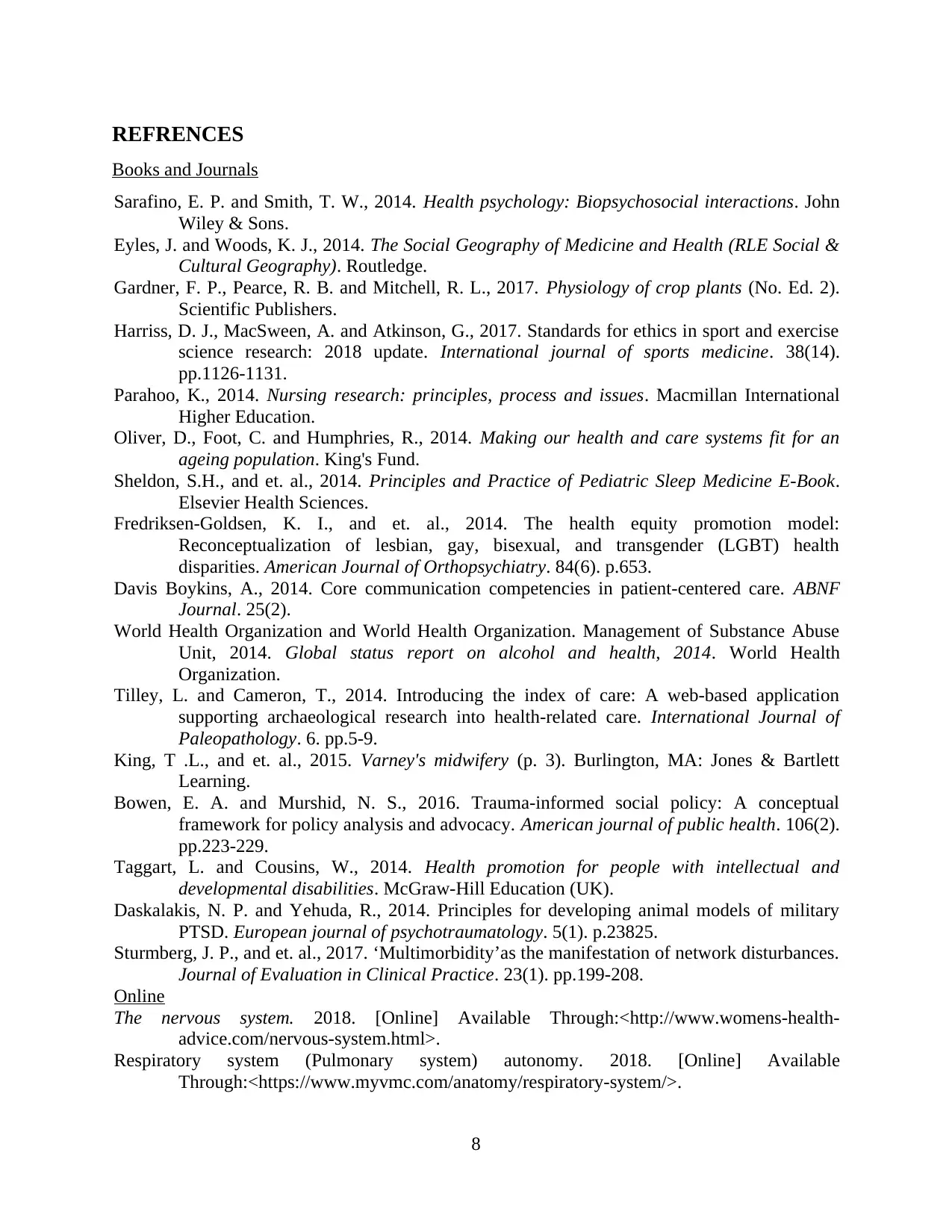
REFRENCES
Books and Journals
Sarafino, E. P. and Smith, T. W., 2014. Health psychology: Biopsychosocial interactions. John
Wiley & Sons.
Eyles, J. and Woods, K. J., 2014. The Social Geography of Medicine and Health (RLE Social &
Cultural Geography). Routledge.
Gardner, F. P., Pearce, R. B. and Mitchell, R. L., 2017. Physiology of crop plants (No. Ed. 2).
Scientific Publishers.
Harriss, D. J., MacSween, A. and Atkinson, G., 2017. Standards for ethics in sport and exercise
science research: 2018 update. International journal of sports medicine. 38(14).
pp.1126-1131.
Parahoo, K., 2014. Nursing research: principles, process and issues. Macmillan International
Higher Education.
Oliver, D., Foot, C. and Humphries, R., 2014. Making our health and care systems fit for an
ageing population. King's Fund.
Sheldon, S.H., and et. al., 2014. Principles and Practice of Pediatric Sleep Medicine E-Book.
Elsevier Health Sciences.
Fredriksen-Goldsen, K. I., and et. al., 2014. The health equity promotion model:
Reconceptualization of lesbian, gay, bisexual, and transgender (LGBT) health
disparities. American Journal of Orthopsychiatry. 84(6). p.653.
Davis Boykins, A., 2014. Core communication competencies in patient-centered care. ABNF
Journal. 25(2).
World Health Organization and World Health Organization. Management of Substance Abuse
Unit, 2014. Global status report on alcohol and health, 2014. World Health
Organization.
Tilley, L. and Cameron, T., 2014. Introducing the index of care: A web-based application
supporting archaeological research into health-related care. International Journal of
Paleopathology. 6. pp.5-9.
King, T .L., and et. al., 2015. Varney's midwifery (p. 3). Burlington, MA: Jones & Bartlett
Learning.
Bowen, E. A. and Murshid, N. S., 2016. Trauma-informed social policy: A conceptual
framework for policy analysis and advocacy. American journal of public health. 106(2).
pp.223-229.
Taggart, L. and Cousins, W., 2014. Health promotion for people with intellectual and
developmental disabilities. McGraw-Hill Education (UK).
Daskalakis, N. P. and Yehuda, R., 2014. Principles for developing animal models of military
PTSD. European journal of psychotraumatology. 5(1). p.23825.
Sturmberg, J. P., and et. al., 2017. ‘Multimorbidity’as the manifestation of network disturbances.
Journal of Evaluation in Clinical Practice. 23(1). pp.199-208.
Online
The nervous system. 2018. [Online] Available Through:<http://www.womens-health-
advice.com/nervous-system.html>.
Respiratory system (Pulmonary system) autonomy. 2018. [Online] Available
Through:<https://www.myvmc.com/anatomy/respiratory-system/>.
8
Books and Journals
Sarafino, E. P. and Smith, T. W., 2014. Health psychology: Biopsychosocial interactions. John
Wiley & Sons.
Eyles, J. and Woods, K. J., 2014. The Social Geography of Medicine and Health (RLE Social &
Cultural Geography). Routledge.
Gardner, F. P., Pearce, R. B. and Mitchell, R. L., 2017. Physiology of crop plants (No. Ed. 2).
Scientific Publishers.
Harriss, D. J., MacSween, A. and Atkinson, G., 2017. Standards for ethics in sport and exercise
science research: 2018 update. International journal of sports medicine. 38(14).
pp.1126-1131.
Parahoo, K., 2014. Nursing research: principles, process and issues. Macmillan International
Higher Education.
Oliver, D., Foot, C. and Humphries, R., 2014. Making our health and care systems fit for an
ageing population. King's Fund.
Sheldon, S.H., and et. al., 2014. Principles and Practice of Pediatric Sleep Medicine E-Book.
Elsevier Health Sciences.
Fredriksen-Goldsen, K. I., and et. al., 2014. The health equity promotion model:
Reconceptualization of lesbian, gay, bisexual, and transgender (LGBT) health
disparities. American Journal of Orthopsychiatry. 84(6). p.653.
Davis Boykins, A., 2014. Core communication competencies in patient-centered care. ABNF
Journal. 25(2).
World Health Organization and World Health Organization. Management of Substance Abuse
Unit, 2014. Global status report on alcohol and health, 2014. World Health
Organization.
Tilley, L. and Cameron, T., 2014. Introducing the index of care: A web-based application
supporting archaeological research into health-related care. International Journal of
Paleopathology. 6. pp.5-9.
King, T .L., and et. al., 2015. Varney's midwifery (p. 3). Burlington, MA: Jones & Bartlett
Learning.
Bowen, E. A. and Murshid, N. S., 2016. Trauma-informed social policy: A conceptual
framework for policy analysis and advocacy. American journal of public health. 106(2).
pp.223-229.
Taggart, L. and Cousins, W., 2014. Health promotion for people with intellectual and
developmental disabilities. McGraw-Hill Education (UK).
Daskalakis, N. P. and Yehuda, R., 2014. Principles for developing animal models of military
PTSD. European journal of psychotraumatology. 5(1). p.23825.
Sturmberg, J. P., and et. al., 2017. ‘Multimorbidity’as the manifestation of network disturbances.
Journal of Evaluation in Clinical Practice. 23(1). pp.199-208.
Online
The nervous system. 2018. [Online] Available Through:<http://www.womens-health-
advice.com/nervous-system.html>.
Respiratory system (Pulmonary system) autonomy. 2018. [Online] Available
Through:<https://www.myvmc.com/anatomy/respiratory-system/>.
8
1 out of 10
Related Documents
Your All-in-One AI-Powered Toolkit for Academic Success.
+13062052269
info@desklib.com
Available 24*7 on WhatsApp / Email
![[object Object]](/_next/static/media/star-bottom.7253800d.svg)
Unlock your academic potential
Copyright © 2020–2025 A2Z Services. All Rights Reserved. Developed and managed by ZUCOL.





